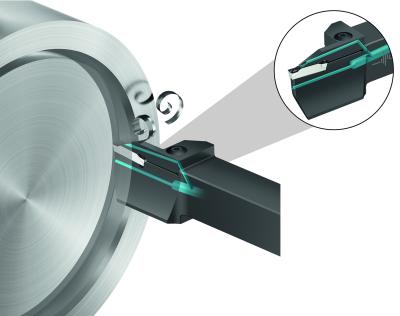
Walter has introduced the Walter Cut G1111-P/GX24 AF5 axial grooving system, featuring the G1111-P GX monoblock tool for axial grooving and groove-turning with precision cooling. It provides reliability and longer insert life due to its reinforced cutting edge (e.g. with forged parts), and incorporates precision cooling on the rake face with a coolant jet aimed at the clearance face for flushing the chips out of the axial groove.
The system handles axial grooves from dia. 2.362-in (60 mm), cutting depths up to 1.299-in (33 mm), with insert width of 0.197-in (5 mm). The new system delivers maximum productivity and cutting parameters due to optimal cooling, strength and controlled chip breaking, along with high cost-efficiency due to two cutting edges. Axial grooving is effective when the groove depth is 1.5 times greater than the groove width, but to be successful axial grooving requires dedicated tooling and a dedicated chip control insert.
Key to the system's success is also the new Walter Cut GX24 grooving insert with AF5 Axial chip breaker. This new right or left-handed asymmetric chip breaker takes into account the variation in cutting speed on the outside and the inside corner of the insert. The new AF5 chip breaker geometry has uneven chip breaker grooves, with shallower groove on the outside cutting corner and deeper groove towards inside cutting corner. This allows for a very efficient chip breaking operation and a smooth, scratch free finished workpiece surface. The Walter Cut G1111-P grooving holder has a diameter range of 2.362-19.685-in. (60–500 mm).
Contact Details
Related Glossary Terms
- clearance
clearance
Space provided behind a tool’s land or relief to prevent rubbing and subsequent premature deterioration of the tool. See land; relief.
- coolant
coolant
Fluid that reduces temperature buildup at the tool/workpiece interface during machining. Normally takes the form of a liquid such as soluble or chemical mixtures (semisynthetic, synthetic) but can be pressurized air or other gas. Because of water’s ability to absorb great quantities of heat, it is widely used as a coolant and vehicle for various cutting compounds, with the water-to-compound ratio varying with the machining task. See cutting fluid; semisynthetic cutting fluid; soluble-oil cutting fluid; synthetic cutting fluid.
- cutting speed
cutting speed
Tangential velocity on the surface of the tool or workpiece at the cutting interface. The formula for cutting speed (sfm) is tool diameter 5 0.26 5 spindle speed (rpm). The formula for feed per tooth (fpt) is table feed (ipm)/number of flutes/spindle speed (rpm). The formula for spindle speed (rpm) is cutting speed (sfm) 5 3.82/tool diameter. The formula for table feed (ipm) is feed per tooth (ftp) 5 number of tool flutes 5 spindle speed (rpm).
- grooving
grooving
Machining grooves and shallow channels. Example: grooving ball-bearing raceways. Typically performed by tools that are capable of light cuts at high feed rates. Imparts high-quality finish.
- rake
rake
Angle of inclination between the face of the cutting tool and the workpiece. If the face of the tool lies in a plane through the axis of the workpiece, the tool is said to have a neutral, or zero, rake. If the inclination of the tool face makes the cutting edge more acute than when the rake angle is zero, the rake is positive. If the inclination of the tool face makes the cutting edge less acute or more blunt than when the rake angle is zero, the rake is negative.

